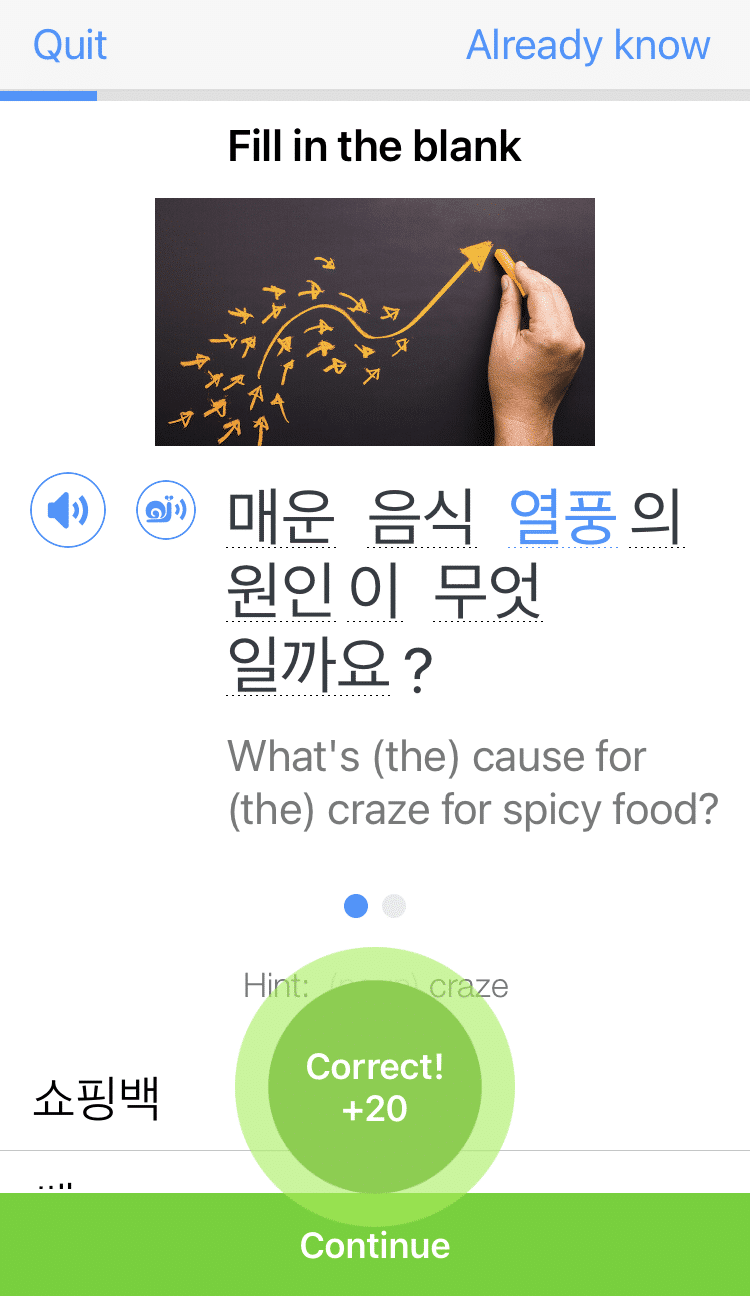95 Korean Vocabulary Words About Food and Cuisine

Did you know kimchi is considered one of the world’s healthiest foods? But get ready for a mouthful, because kimchi is just one of the many foods Koreans love.
In this post, we’re diving deep into Korean for food—음식 (eumsik)—with this vocabulary-expanding food tour. By the end, you will have learned over 95 Korean food vocabulary words you need for ordering food, describing taste, cooking and more.
Download: This blog post is available as a convenient and portable PDF that you can take anywhere. Click here to get a copy. (Download)
How Do You Say “Food” in Korean?
In Korean, the word for food is 음식 (eumshik).
But when talking about eating or referring to a meal, you can use the informal word 밥 (bap), which specifically means cooked rice. But it’s often used colloquially to refer to a meal in general.
So, if you want to say you’re hungry or suggest grabbing a meal, you might say “밥 먹자” (bap meokja), which means “Let’s eat!”
The Korean language often revolves around shared meals and the significance of food in social interactions, making these expressions essential for everyday conversation.
Common Korean Food Words
| Korean | Romanization | English |
|---|---|---|
| 음식 | Eumsik | Food |
| 요리하다 | Yolihada | To cook |
| 저어주다 | Jeoeojuda | To stir |
| 맛보다 | Matboda | To taste |
| 먹다 | Meokda | To eat |
| 마시다 | Masida | To drink |
| 접시 | Jeobsi | Plate |
| 그릇 | Geureut | Bowl |
| 포크 | Pokeu | Fork |
| 숟가락 | Sutgarak | Spoon |
| 칼 | Kal | Knife |
| 젓가락 | Jeotgarak | Chopsticks |
| 식당 / 레스토랑 | Sikdang / reseutorang | Restaurant |
| 생 | Saeng | Raw |
| 패스트푸드 | Paeseuteupudeu | Fast food |
Now that you know a few basic food words in Korean, I suggest learning some useful restaurant phrases.
You can learn 20 with this video lesson from our YouTube channel:
Vegetables in Korean
Korean meals typically contain at least five different colors (green, red, yellow, white and black).
This wallop results in a wide variety of tastes and textures that thrill the palate.
Koreans don’t just eat to quiet a grumbling stomach. They think of food as medicine.
Each meal contains a healthy assortment of veggies that provide nourishment, keep organs in fighting form and boost immunity.
Here’s a listing of common vegetables found on Korean tables and their English translations.
| Korean | Romanization | English |
|---|---|---|
| 생강 | Saenggang | Ginger |
| 인삼 | Insam | Ginseng |
| 양파 | Yangpa | Onion |
| 당근 | Danggeun | Carrot |
| 후추 | Huchu | Pepper |
| 고추 | Gochu | Red pepper |
| 마늘 | Maneul | Garlic |
| 무 | Mu | Radish |
| 상추 | Sangchu | Lettuce |
| 브로콜리 | Beurokkoli | Broccoli |
| 가지 | Gaji | Eggplant |
| 감자 | Gamja | Potato |
| 버섯 | Beoseot | Mushroom |
If you want to learn more vegetables in Korean, I recommend checking out this post:
50 Most Common Vegetables to Know in Korean | FluentU Korean Blog
Knowing the names of Korean vegetables and vegetable dishes is a must. So check out this post that lists the Korean names for common vegetables. You’ll also learn about…
Fruits in Korean
Fruits make up an easy vocabulary group to commit to memory.
Often, the Korean names of fruits sound very similar to the English names. So you just need to “Koreanize” them.
Here are the most common fruits in Korean:
| Korean | Romantization | English |
|---|---|---|
| 오렌지 | Orenji | Orange |
| 망고 | Mango | Mango |
| 바나나 | Banana | Banana |
| 레몬 | Lemon | Lemon |
| 멜론 | Mellon | Melon |
| 체리 | Cheri | Cherry |
| 올리브 | Olibeu | Olive |
| 파인애플 | Painaepeul | Pineapple |
| 파파야 | Papaya | Papaya |
| 토마토 | Tomato | Tomato |
| 포도 | Podo | Grape |
| 사과 | Sagwa | Apple |
| 복숭아 | Boksunga | Peach |
Meats in Korean
Koreans have excellent meat dishes, like 불고기 (bulgogi)—grilled marinated beef slices—and 삼겹살 (samgyeopsal)—grilled pork belly.
I’m sure you’ve heard of “Korean barbecue.”
It’s when you go to a restaurant and spend your hard-earned cash to cook your own food, your own way and love it.
The grill or stove is often built into the table, and you fire up any piece of meat you have on hand. And even grill veggies if you like.
Koreans also love to pair their beer with fried chicken.
치맥 (chimaek) comes from a mashup of 치 (chi) from 치킨 (chikin), which is Korean slang for “fried chicken.” And 맥 (maek) from 맥주 (maekju), which is the Korean word for “beer.”
South Korea is dotted with thousands of 치맥 restaurants that offer different arrays of batter, frying oils and dips.
You don’t even have to dress up to enjoy your chicken. Many restaurants deliver straight to your doorstep.
That said, here’s a list of common Korean meats and their English translations.
| Korean | Romanization | English |
|---|---|---|
| 닭고기 | Dakgogi | Chicken |
| 오리고기 | Origogi | Duck |
| 소고기 | Sogogi | Beef |
| 생선 | Saengseon | Fish |
| 돼지고기 | Dwaejigogi | Pork |
| 스테이크 | Seuteikeu | Steak |
| 베이컨 | Beikon | Bacon |
| 햄 | Haem | Ham |
Food Adjectives in Korean
Now let’s learn a few words to describe food in Korean:
| Korean | Romanization | English |
|---|---|---|
| 맛있는 | Masinneun | Delicious |
| 매운 | Maeun | Spicy |
| 신선한 | Sinseonhan | Fresh |
| 달콤한 | Dalkomhan | Sweet |
| 짭짤한 | Jjapjjalhan | Savory |
| 쓴 | Sseun | Bitter |
| 시원한 | Siwonhan | Refreshing |
| 부드러운 | Budeureoun | Tender, soft |
| 고소한 | Gosohan | Nutty |
| 푸짐한 | Pujimhan | Hearty, generous |
| 건강한 | Geonganghan | Healthy |
| 느끼한 | Neukkihan | Greasy, fatty |
| 매콤한 | Maekomhan | Spicy (Hot) |
| 유명한 | Yumyeonghan | Famous |
| 기름진 | Gireumjin | Oily, greasy |
You can also watch this video lesson for more descriptors:
Drinks in Korean
Koreans also have a wide range of common beverages, from banana milk, to teas, to alcoholic drinks that not only reflect history but also make drinking games really fun.
Koreans have many teas, like citron, omija, corn, barley, chrysanthemum and green plum.
These are known for their exquisite taste and positive effects on the body.
Koreans observe drinking etiquette. When receiving a drink, receive it with both hands—the right hand holds the glass, and the left hand supports the bottom.
Here’s a list of some of the most common drinks in Korean.
| Korean | Romanization | English |
|---|---|---|
| 물 | Mul | Water |
| 주스 | Juseu | Juice |
| 우유 | Uyu | Milk |
| 차 | Cha | Tea |
| 맥주 | Maekju | Beer |
| 소주 | Soju | Distilled spirits |
| 막걸리 | Makgeolli | Rice wine |
| 커피 | Keopi | Coffee |
Cooking Ingredients in Korean
Korean food is known for being spicy.
One slurp of 육개장 (yukgaejang)—a beef and vegetable soup—and you know what it would be like to lose your tongue and lips in an inferno.
But Korean cuisine isn’t just about the heat.
It’s about the whole range of flavor profiles—from savory, to sweet, to sour, to bitter and salty.
Here’s a list of some seasonings and ingredients that give flexibility and flair to Korean dishes.
| Korean | Romanization | English |
|---|---|---|
| 소금 | Sogeum | Salt |
| 식초 | Sigcho | Vinegar |
| 간장 | Ganjang | Soy sauce |
| 설탕 | Sultang | Sugar |
| 기름 | Gileum | Oil |
| 밀가루 | Milgaru | Flour |
| 계란 | Gyeran | Egg |
| 버터 | Beoteo | Butter |
| 치즈 | Chijeu | Cheese |
Famous Korean Dishes
So, we’ve done individual food items.
My advice is to memorize and practice this vocab so you can properly pronounce each item.
Create a dedicated flashcard deck on Anki and check out some Korean food videos on FluentU.
FluentU takes authentic videos—like music videos, movie trailers, news and inspiring talks—and turns them into personalized language learning lessons.
You can try FluentU for free for 2 weeks. Check out the website or download the iOS app or Android app.
P.S. Click here to take advantage of our current sale! (Expires at the end of this month.)
But are you wondering what happens when you cook and mix all those meats, vegetables and flavors?
Here are some of the most famous Korean dishes that deserve a permanent place in your vocabulary. And a temporary home in your mouth.
You can find even more in this video from sweetandtastyTV.
Rice Dishes
밥 (bap) is “rice” in Korean.
Every time you see 밥 on a menu, expect a bed of rice somewhere on the plate.
Famous examples of rice dishes include:
| Korean | Romanization | English |
|---|---|---|
| 흰밥 | Huinbap | White rice |
| 볶음밥 | Bokkeumbap | Fried rice |
| 김밥 | Kimbap | Seaweed rice roll |
| 비빔밥 | Bibimbap | Mixed rice with vegetables |
김밥 looks very similar to sushi because they’re both wrapped in dark seaweed sheets.
김밥 tends to be a bit sweeter and often doesn’t include raw fish.
Instead, you get meat fillings like beef, ham, crab meat and pork cutlets, surrounded by veggies like radish, cucumber, kimchi and perilla leaves.
비빔밥 is sauteed veggies, meat and chili pepper paste placed on a bed of rice.
Your job is to mix all the ingredients before taking a mouthful. Sometimes, a raw or fried egg is added.
Stews
| Korean | Romanization | English |
|---|---|---|
| 김치찌개 | Gimchi-jjigae | Kimchi stew |
| 된장찌개 | Doenjang-jjigae | Fermented soybean paste stew |
| 부대찌개 | Budae-jjigae | "Army stew" |
An assortment of available meats, seafood and veggies is thrown into 된장찌개. (Add a little bit of chili paste to show your date how brave you are.)
부대찌개 contains Spam, sausages, cheese, ham, baked beans—in short, all the different ingredients available on a U.S. Army base.
They’re thrown together in a pot and reinforced with stuff like kimchi, chili paste, ramyeon noodles and a platoon of available veggies.
Soups
| Korean | Romanization | English |
|---|---|---|
| 삼계탕 | Samgyetang | Chicken ginseng soup |
| 갈비탕 | Galbitang | Short ribs soup |
| 미역국 | Miyeokguk | Seaweed soup |
Koreans often eat 삼계탕 during the summer months. Imagine slurping warm soup flavored by a whole chicken that’s stuffed with ginseng, garlic, pine nuts, jujubes and of course, sticky rice.
갈비탕 is made by simmering beef short ribs for several hours and throwing in onions, radish, green onions, garlic, black pepper and even noodles.
The hearty dish is often served during weddings, although you can get one any day of the week from a good Korean restaurant.
Because 미역국 is rich in calcium and iodine, seaweed soup is often served to mothers after giving birth.
And because of this, as homage to one’s mother, 미역국 is also traditionally eaten for breakfast on birthdays.
Noodles
| Korean | Romanization | English |
|---|---|---|
| 라면 | Ramyun | Instant noodles |
| 짜장면 | Jjajangmyun | Black bean noodles |
| 냉면 | Naengmyun | Cold noodles |
라면 is Korea’s answer to Japan’s ramen.
짜장면 is noodles served with black bean paste, some soy/oyster sauce and topped with a little meat/seafood. Along with some aromatics and veggies.
The dish looks like a squid squirted ink on your noodles. And yes, it really is tasty!
Side Dishes
The Korean side dishes that dot your table are called 반찬 (banchan).
Unlike Western meals, where your food comes in courses—soup, appetizer, salad, main course and dessert—Korean dishes are served all at once.
The basic table setting is called 반상 (bansang).
In front of you, you’ll have a rice bowl and a soup bowl that will sit side by side.
In front of them—farther from you—will be the condiments like chili and soy sauce.
Hot foods—like stews—will be placed on your right. Cold dishes will be on your left. Side dishes will be placed in front of the condiments, in the third row.
(Here’s an article that explains Korean table setting in more detail.)
When you look at everything together, you’ll see all the different colors of the 반찬.
You’ll have your sweet, sour, salty and savory side dishes, and there’s no proper order to eating them. You can have them at any time during the meal.
To give you an idea of the great number of Korean side dishes, here’s an infographic of what’s possible.
Some examples of 반찬 are:
| Korean | Romanization | English |
|---|---|---|
| 김치 | Gimchi | Spicy pickled cabbage |
| 잡채 | Japchae | Stir-fried glass noodles mixed with vegetables |
| 계란말이 | Gyeran-mari | Rolled omelette |
| 가지나물 | Gaji-namul | Seasoned eggplants |
| 멸치볶음 | Myeolchi-bokkeum | Stir-fried dried anchovies |
So there you go—the biggest buffet of words in Korean for food lovers!
You now have a full buffet of Korean food vocabulary. You know individual food items in Korean, as well as Korean dishes that are worth a try.
When you have a chance, go visit a Korean restaurant and have a taste of what you’re talking about!
Download: This blog post is available as a convenient and portable PDF that you can take anywhere. Click here to get a copy. (Download)
And One More Thing...
If you enjoyed this post, you're already halfway to having the time of your life learning Korean with FluentU!
FluentU makes it possible to learn with K-pop videos, funny commercials, entertaining web series and more. Just a quick look will give you an idea of the variety of FluentU videos on offer:

FluentU really takes the grunt work out of learning languages, leaving you with nothing but engaging, effective and efficient learning. It's already hand-picked the best videos for you (which are organized by level and topic), so all you have to do is simply choose any video that strikes your fancy to get started.
Each word in the interactive captions comes with a definition, audio, image, example sentences and more.

Access a complete interactive transcript of every video under the Dialogue tab, and easily review words and phrases from the video under Vocab.

You can use FluentU’s unique Quiz Mode to learn the vocabulary and phrases from the video through fun questions.

FluentU keeps track of what you're learning, and tells you exactly when it's time for review, giving you a 100% personalized experience.
Review sessions use video context to help embed the words in your memory.
Start using the FluentU website on your computer or tablet or, better yet, download the FluentU app from the iTunes or Google Play store. Click here to take advantage of our current sale! (Expires at the end of this month.)








